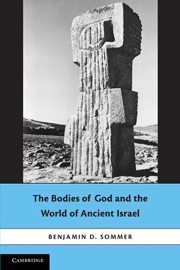Book contents
- Frontmatter
- Contents
- Preface
- Acknowledgments
- Introduction: God's Body and the Bible's Interpreters
- 1 Fluidity of Divine Embodiment and Selfhood: Mesopotamia and Canaan
- 2 The Fluidity Model in Ancient Israel
- 3 The Rejection of the Fluidity Model in Ancient Israel
- 4 God's Bodies and Sacred Space (1): Tent, Ark, and Temple
- 5 God's Bodies and Sacred Space (2): Difficult Beginnings
- 6 The Perception of Divinity in Biblical Tradition: Implications and Afterlife
- Appendix: Monotheism and Polytheism in Ancient Israel
- Notes
- List of Abbreviations
- Bibliography
- Scriptural Index
- Index of Rabbinic Citations
- Subject Index
5 - God's Bodies and Sacred Space (2): Difficult Beginnings
Published online by Cambridge University Press: 15 September 2009
- Frontmatter
- Contents
- Preface
- Acknowledgments
- Introduction: God's Body and the Bible's Interpreters
- 1 Fluidity of Divine Embodiment and Selfhood: Mesopotamia and Canaan
- 2 The Fluidity Model in Ancient Israel
- 3 The Rejection of the Fluidity Model in Ancient Israel
- 4 God's Bodies and Sacred Space (1): Tent, Ark, and Temple
- 5 God's Bodies and Sacred Space (2): Difficult Beginnings
- 6 The Perception of Divinity in Biblical Tradition: Implications and Afterlife
- Appendix: Monotheism and Polytheism in Ancient Israel
- Notes
- List of Abbreviations
- Bibliography
- Scriptural Index
- Index of Rabbinic Citations
- Subject Index
Summary
In the previous chapter, we noted a correlation between a tradition's understanding of divine embodiment and its attitudes toward sacred space. The tent of meeting found in the E strand of the Pentateuch, which is one of the fluidity traditions, embraces an attitude toward sacred space that celebrates what the theorist of religion J. Z. Smith calls the peripheral or the centrifugal: There is no one sacred center, so that the sacred can manifest itself some distance from the center of the Israelite camp. For E, Yhwh can have multiple bodies, and therefore no single location can claim a monopoly on the sacred. The stances of P and D were more complex. Each one endorses the notion of a sacred center, but each one also deflates or undermines that notion. The sacred center in P was not limited to a fixed location, but, in the form of the tabernacle, was mobile. Thus P displayed not what Smith terms a locative stance but what I call a locomotive one: There is a single sacred center, but it moves. By linking the tabernacle, a symbol or predecessor of the Jerusalem temple, with a nomadic tent that belongs to no one place, the priestly document moves in two opposing directions, toward the center and toward the periphery, and thus it opens the door for a critique of its own theology of presence.
- Type
- Chapter
- Information
- The Bodies of God and the World of Ancient Israel , pp. 109 - 123Publisher: Cambridge University PressPrint publication year: 2009



